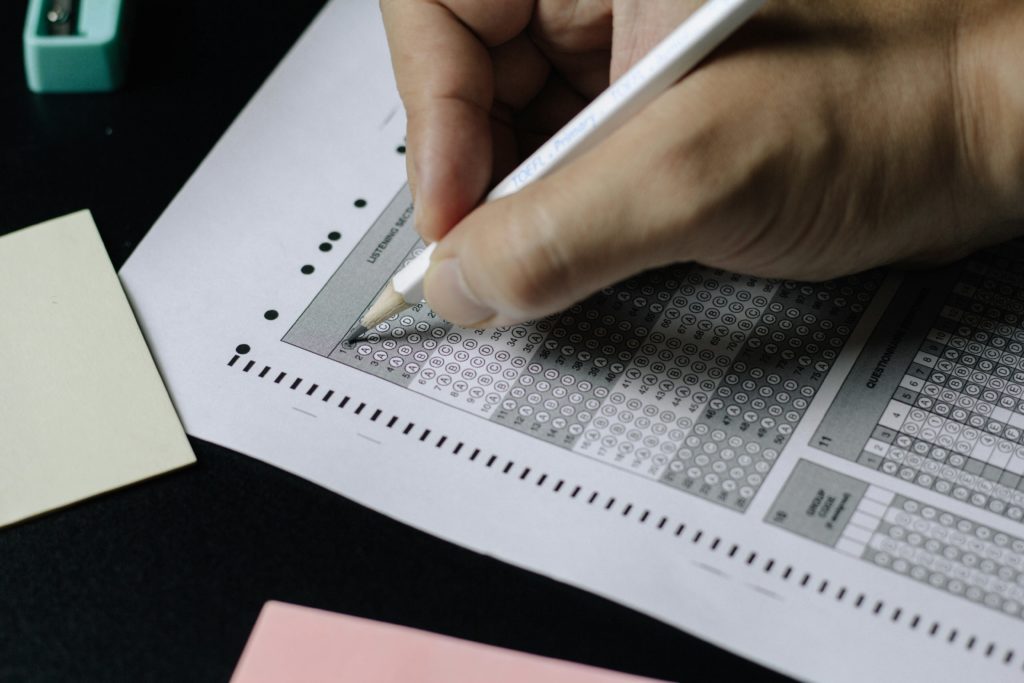Student-centric advice and objective recommendations
Higher education has never been more confusing or expensive. Our goal is to help you navigate the very big decisions related to higher ed with objective information and expert advice. Each piece of content on the site is original, based on extensive research, and reviewed by multiple editors, including a subject matter expert. This ensures that all of our content is up-to-date, useful, accurate, and thorough.
Our reviews and recommendations are based on extensive research, testing, and feedback. We may receive commission from links on our website, but that doesn’t affect our editors’ opinions. Our marketing partners don’t review, approve or endorse our editorial content. It’s accurate to the best of our knowledge when posted. You can find a complete list of our partners here.
What is the PSAT 10? Everything You Need to Know
 By
Cece Gilmore
By
Cece Gilmore 
Cece Gilmore is a Content Writer at Scholarships360. Cece earned her undergraduate degree in Journalism and Mass Communications from Arizona State University. While at ASU, she was the education editor as well as a published staff reporter at Downtown Devil. Cece was also the co-host of her own radio show on Blaze Radio ASU.
Full BioLearn about our editorial policies

Maria Geiger is Director of Content at Scholarships360. She is a former online educational technology instructor and adjunct writing instructor. In addition to education reform, Maria’s interests include viewpoint diversity, blended/flipped learning, digital communication, and integrating media/web tools into the curriculum to better facilitate student engagement. Maria earned both a B.A. and an M.A. in English Literature from Monmouth University, an M. Ed. in Education from Monmouth University, and a Virtual Online Teaching Certificate (VOLT) from the University of Pennsylvania.
Full BioLearn about our editorial policies

The College Board offers the PSAT 10 which is a precursor to the PSAT/NMSQT and the SAT as a part of the College Board’s SAT Suite of Assessments. So, what exactly is the PSAT 10? Read more to find out everything you need to know about the PSAT 10!
What is the PSAT 10?
The PSAT 10 is an exam that is part of the College Board’s SAT Suite of Assessments. The PSAT 10 helps both educators and students track their progress and gain an idea of how they will perform on the SAT and provides insight on what AP courses they will likely succeed in.
Also see: Easiest AP classes you can take
What is on the PSAT 10?
The PSAT 10 lasts two hours and fourteen minutes. There is a reading and writing section and a math section. Most of the questions are multiple choice, however, on the math section there may be questions that ask you to write in the answer. The structure of the PSAT 10 is very similar to the SAT, however, there is no essay section on the PSAT 10.
The time allotted and number of questions on the PSAT 10 is broken down in the chart below:
| Section | Length (minutes) | Number of questions |
| Reading and writing | 64 | 54 |
| Math | 70 | 44 |
| Total | 134 | 98 |
Related: PSAT vs SAT: everything you need to know
Reading and writing section
The reading and writing section of the PSAT 10 includes 54 multiple-choice questions evenly divided into 2 modules. You will have around 32 minutes to answer the questions in each module.
The passages found in the PSAT 10 will include subject areas of literature, history/social studies, the humanities and science.
The reading and writing section of the PSAT 10 includes questions that fall into four categories:
- Craft and structure
- Information and ideas
- Standard English conventions
- Expression of ideas
Also see: Top SAT reading tips
Math section
The math section of the PSAT 10 is divided into 2 parts: a no-calculator portion and a calculator-portion. In both sections, most of the test is multiple-choice, however, some of the questions may ask you to write out the answers.
The math section of the PSAT 10 includes questions that fall into four categories:
- Heart of algebra (around 16 questions)
- Problem solving and data analysis (around 16 questions)
- Passport to advanced math (around 14 questions)
- Additional topics in math (around 2 questions)
The chart below breaks down the structure of the math section of the PSAT 10:
| No-calculator section | Calculator-section | |
| Time allotted | 25 minutes | 45 minutes |
| Total questions | 17 questions | 31 questions |
| Multiple-choice questions | 10 questions | 27 questions |
| Write-in questions | 4 questions | 4 questions |
Related: Top SAT math tips
When is the PSAT 10 offered?
Typically, your school will choose when to offer the PSAT 10. However, testing is available between March 3rd and April 30th, 2025. So, expect your exam to be in that timeframe. If you are curious about when your specific school will be offering the PSAT 10, you should reach out to your school counselor.
Is the PSAT 10 digital?
Yes! The PSAT 10 has gone digital as a part of the College Board’s efforts to turn most of their exams online. This means that students taking the PSAT 10 will be using the Bluebook software to take the exam either on a school device or on an approved personal computer.
Below is a list of the required items you must bring on the PSAT 10 testing day:
- Acceptable photo ID
- Fully charged testing device with the exam app downloaded
- Acceptable calculator
- Pen or pencil for scratch work (does not need to be a No. 2 pencil)
Below is a list of items you can bring to the PSAT 10 testing day but it is not mandatory:
- A power cord or portable charger
- An external mouse and mouse pad
- An external keyboard (cannot be used with laptops, only tablets)
Below is a list of PROHIBITED items for the PSAT 10:
- Electronic equipment including phones, smart watches, fitness trackers, cameras and any other type of electronic device besides your approved testing device
- Books, notes, compasses, protractors, dictionaries, highlighters or colored pencils
- Papers of any kind
- Watches that beep or have an alarm
- Non-approved calculators
- Reference guides, keyboard maps or other typing instructions
- Ear plugs or headphones
- Weapons
Related: The digital SAT: everything you need to know
How is the PSAT 10 scored?
After you take the PSAT 10 you will receive a score report that includes your score, your score range, and the all tester percentile. You are scored between 320-1520 for your total score and 160-760 for section scores.
Your score range shows how much your scores would likely vary if you took a different administration of the test under identical conditions. The ranges are typically +/- 40 total and +/- 30 per section.
The all tester percentile reveals how you did in comparison to other students who took the PSAT 10. For example, if you scored in the 70th percentile, then 70% of a comparison group of students achieved scores at or below that student’s score. Therefore, the higher the percentile, the better you did.
Additionally, you will receive a knowledge and skills section of your score report that reveals your performance on each of the 8 content areas measured on the PSAT 10. You will be able to see the approximate number of questions in the content area, the percentage of the section covered by that area and a visual representation of how you performed in each area. This can help you determine your strengths and weaknesses and can help improve your SAT score.
Also see: PSAT to SAT score conversion: predict your score
What is a PSAT 10 benchmark score?
Benchmarks are scores that represent college readiness on the PSAT 10. Students who score at or above the benchmark are deemed “on track” for college level academics after graduating high school.
The average PSAT 10 score is around 920. A score between 1210 and 1520 places you in the top 10% of test takers.
It is important to note that if you score below the benchmark, it does not mean that you cannot go to college or that you are not ready for college. Rather, you should look at it as a score that shows you what areas you should improve upon. The detailed feedback you receive on your PSAT 10 report will help you determine what subject areas and skills you should work on before graduating high school.
What is the AP potential report?
SAT Suite of Assessment scores are typically a strong predictor of a student’s AP Exam scores. The AP Potential report is a free tool that allows schools to generate a roster of students who are likely to score a 3 or higher on AP Exams based on their performance on the PSAT 8/9, PSAT 10, PSAT/NMSQT or SAT.
When students receive their PSAT 10 scores, they will be able to see their AP potential report along with the ability to connect with career and college tools. The AP potential report is a great tool for determining if a student is ready for an AP level course or not. However, it is important to note that the report is not meant to discourage students from taking AP courses. Other factors should be considered when determining if an AP course is right for you.
Also see: 2024 AP test changes: what you need to know
PSAT 10 vs PSAT 8/9 vs PSAT/NMSQT
| PSAT 10 | PSAT 8/9 | PSAT/NMSQT | |
| Range of scores | 320-1520 | 240-1440 | 320-1520 |
| Length | 2 hours and 14 minutes | 2 hours and 14 minutes | 2 hours and 14 minutes |
| Age | Sophomore | 8th and 9th grade | Sophomore or junior |
| Number of reading and writing questions | 54 | 54 | 54 |
| Number of math questions | 44 | 44 | 44 |
| National Merit Scholarship opportunity? | No | No | Yes |
Should students take the PSAT 10?
The PSAT 10 is a great practice tool for gaining an understanding of how you will perform on the SAT. Based on how you do on the PSAT 10, you can obtain free personalized practice for the SAT. This is because you will see what areas you need to improve upon and what areas are your strengths for the actual SAT. Additionally, the PSAT 10 provides insight to teachers and students on what AP courses they will likely succeed at. The PSAT 10 also offers opportunities to students to earn scholarships and academic recognition.
Ultimately, the PSAT 10 is not necessary to take if you feel confident in your abilities in terms of readiness for the SAT. The PSAT 10 is a study tool for the SAT. Therefore, whether or not taking the PSAT 10 will be beneficial for you depends on your personal academic needs and goals.
Related: Should I take the SAT/ACT?
Frequently asked questions about the PSAT 10
Is the PSAT 10 free?
Who do the PSAT 10 scores get sent to?
How is the PSAT 10 different from the PSAT/NMSQT?
Can students retake the PSAT10?





